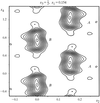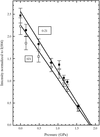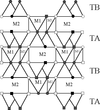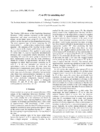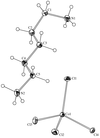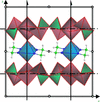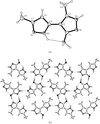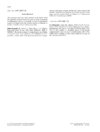issue contents
December 1999 issue

Cover illustration: An infinite hydrogen-bonded sheet in guanidinium trifluoromethanesulfonate. Courtesy of C. B. Aakeröy [Acta Cryst. (1997), B53, 569-586; structure determined by V. A. Russell, M. C. Etter & M. D. Ward].
topical reviews
Simple three-dimensional nets are the basis for families of structures homeomorphic to these nets. At their vertices may be single atoms, coordination polyhedra or clusters of coordination polyhedra.
research papers
Download citation


Download citation


The charge density in NiCl2.4H2O has been determined at 295 and 30 K, with H-atom parameters from X-ray and, independently, from neutron data; at 30 K one water molecule is disordered.
The structure of a new hexagonal perovskite phase, Sr14/11CoO3, was determined from single-crystal X-ray diffraction data, using (3 + 1)-dimensional formalism. Crenel functions and a Gram–Charlier anharmonic development of the atomic displacement factor were used to accurately describe the Co atoms. A displacement of the prismatic Co atoms was clearly evidenced.
Download citation


Download citation


In pentathulium dirhenium dodecaoxide, ReO6 octahedra, monocapped trigonal TmO7 prisms and TmO6 octahedra form chains of ReO6 octahedra with metallic rhenium–rhenium bonds.
By considering the effects of combinations of octahedral tilts on the symmetries of layered AnBnX3n+2 structures, the space groups associated with different tilt systems were determined for structures with different layer thicknesses (n values) and stacking arrangements. Comparison of these results with literature data suggests that the symmetries of most observed AnBnX3n+2 compounds are fully determined by the tilt systems adopted by rigid BX6 octahedra.
Data collected on both Nonius (Kappa CCD) and Siemens–Bruker (Smart) CCD detector diffractometers were used for the electron density determination of the mineral α-spodumene. Careful comparisons were made with point-detector CAD-4 system derived results.
Crystal morphologies for the title compounds were successfully predicted using attachment energies computed with only the Coulomb potential. There is a systematic variation between the early-growth morphologies and the morphologies of the mature crystals.
Download citation


Download citation


The superstructures of the  -type compound Cs
-type compound Cs HgCl
HgCl are found to involve rotations, distortions and shifts of the HgCl
are found to involve rotations, distortions and shifts of the HgCl groups. The superspace approach gives a unified description of the low-temperature modulated structures and the normal phase at room temperature.
groups. The superspace approach gives a unified description of the low-temperature modulated structures and the normal phase at room temperature.
CIF reference: /b/se0279/se0279.cif
Single-crystal X-ray diffraction has been used to show that lead phosphate, Pb3(PO4)2, undergoes an improper ferroelastic phase transition from C2/c to R3¯m (or R3m) symmetry at 1.81 ± 0.01 GPa at 298 ± 1 K. The spontaneous strain components evolve linearly with pressure, indicating that the effective critical exponent for the phase transition is β = ½.
It is shown that the charge distribution method is well suited to analyse the correctness of a structure and to investigate the structural changes with composition, temperature and pressure. Examples of applications to pyroxenes are given. A computer program is available.
The first investigation of electron density in inorganic compounds made by the vacuum-camera-imaging plate method is reported. The results are compared with those from very accurate conventional four-circle measurements.
Multipole, orbital and topological analyses of the electron density, and calculation of the electrostatic potential, of KNiF3 has been performed using precision X-ray diffraction data measured by vacuum-camera-imaging plate and by four-circle diffractometer methods. The results are compared and some reasons for their discrepancy are discussed.
Approximately 20% of the entries under space group P1 (No. 1) in the October 1998 release of the Cambridge Structural Database belong in other space groups, usually  (No. 2). Over half of these corrections have been made in the latest release.
(No. 2). Over half of these corrections have been made in the latest release.
Download citation


Download citation


The structure of Cs2(HSO4)(H2PO4), a new proton conductor, has been solved by single crystal X-ray methods. The structure contains sheets of hydrogen-bonded (S,P)O4 groups, interleaved with zigzag rows of Cs ions.
Download citation


Download citation


The compound [NH3(CH2)5NH3)]CoCl4 contains slightly distorted tetrachlorocobaltate anions hydrogen-bonded to diprotonated cadaverine cations. The magnetic behaviour is in agreement with the 4A2 ground state of the CoCl anion.
anion.
Download citation


Download citation


The crystal structure of hydrothermally prepared [Ni(NH2CH2CH2NH2)2](V6O14) was determined and appears to have disordered stacking of the vanadium oxide layers. Combinatorial analysis of the layered V6O14 structures was conducted, giving ten possible symmetry groups of the V6O14 layers.
Download citation


Download citation


The structures of six thiophenes possessing oxygen-containing substituents have been determined and their intramolecular and intermolecular geometry analysed.
Download citation


Download citation


The crystal structure with seven conformers in an asymmetric unit is determined. Conformational characteristics of a flexible dipeptide are described using solid-state data and molecular modelling; predominance of folded over extended shapes is found. The presence of protecting groups does not reduce the flexibility of the molecule.
Download citation


Download citation


In a survey of NH-pyrazoles, a limited number of compounds are found to form homonuclear N+—H⋯N positive-charge-assisted hydrogen bonds with N⋯N distances as short as 2.71 Å, while most NH-pyrazoles pack by means of neutral N—H⋯N bonds which are formally assisted by resonance. The resonance does not appear to shorten this bond except in 3,5 symmetrically substituted pyrazoles which display N⋯N distances as short as 2.82 Å associated with an increased internal resonance of the ring and N—H⋯N proton disorder.
Download citation


Download citation


The crystal structures of six anti-β-ketoarylhydrazones containing the conjugated H—N—N=C—C=O heterodienic group are reported. The anti-β-ketoarylhydrazone group is able to form two main types of interaction: the intermolecular N—H—O hydrogen bonding assisted by resonance (RAHB-inter) linking the molecules in infinite chains, and a dipole–dipole (DD) interaction between two carbonyl groups linking the molecules in antiparallel dimers. Different packing arrangements are determined by the presence of various substituents at the phenyl ring, which are able to switch from RAHB-inter to DD interactions or to non-resonant hydrogen bondings.
Download citation


Download citation


A comparative study of the crystal structures of tetrahalogenated hydroquinones and γ-hydroquinone
The crystal structures of the title hydroquinones display topologically similar O—H⋯O networks. It is observed that the C—F group resembles neither C—H group nor C—Cl and C—Br groups in its packing characteristics and that it disfavours the structural alternatives provided by the three latter groups.
Download citation


Download citation


A new phase transition has been discovered for tetrakis(trimethylsilyl)methane C[Si(CH3)3]4. The crystal and molecular structures of C[Si(CH3)3]4 and tetrakis(trimethylsilyl)silane Si[Si(CH3)3]4 have been determined for all phases by Rietveld refinement. The phase transitions have been characterized by DSC, NMR and molecular modeling.
The mathematical basis of graph-set analysis of hydrogen-bond patterns in crystals is presented by defining terms and developing tools for its treatment and subsequent implementation in suitable software algorithms.
A method of visualizing intermolecular networks in the crystalline state, based on expansion of the structure through link atoms in contact with the unique molecule(s) in the crystal chemical unit, is described. Algorithms have been developed for the automatic assignment of graph-set notation, up to second level, to networks that involve asymmetric molecules.
Download citation


Download citation


TEMPO radicals showing magnetic interactions. II. 4-(Benzylideneamino)-TEMPO and related compounds
Crystal structures of 4-(Ar-methyleneamino)-TEMPO radicals (Ar = Ph, 4-MeS-Ph, 4-Me-Ph, 4-PhO-Ph, 4-MeSO -Ph, 3-pyridyl and 2-naphthyl; TEMPO = 2,2,6,6-tetramethylpiperidyl-1-oxyl) have been determined and intermolecular magnetic interactions based on the structures are discussed.
-Ph, 3-pyridyl and 2-naphthyl; TEMPO = 2,2,6,6-tetramethylpiperidyl-1-oxyl) have been determined and intermolecular magnetic interactions based on the structures are discussed.
Download citation


Download citation


The crystal structure of 2,4,6-triisopropylbenzenesulfonamide, C15H25NO2S, has been solved by the Monte Carlo method from X-ray powder diffraction data collected at 120 (1) K using synchrotron radiation. The stucture contains molecules linked by N—H⋯O hydrogen bonds into two-dimensional sheets built from  and
and  rings.
rings.
Symmetry operations applied only to finite regions of a three-dimensional crystal may, under certain conditions, lead to new crystals and solids. Examples for this new phenomenon are shown to exist in organic crystals.
Download citation


Download citation


Highly redundant data collected from a very large crystal with a CCD detector give an excellent structure after correction for systematic errors.
A new isostructurality index based on the overlap of molecular volumes is proposed and tested on various isostructural crystal pairs including associates.
short communications
An error in the figures is reported in the paper by Onoda et al. [Acta Cryst. (1999), B55, 721–725.
books received
Free 

Free 



 journal menu
journal menu













